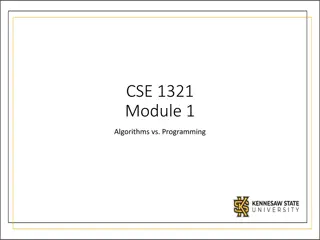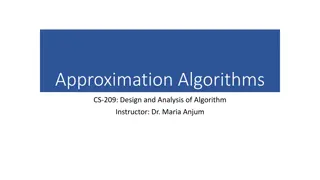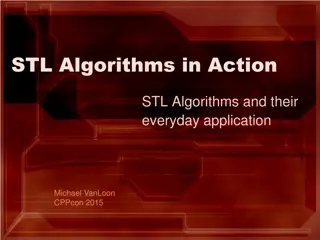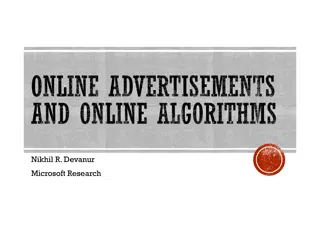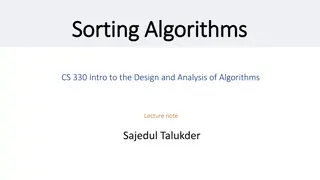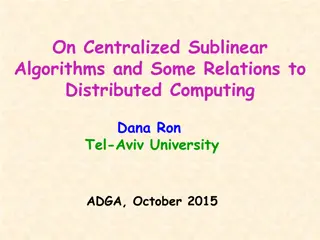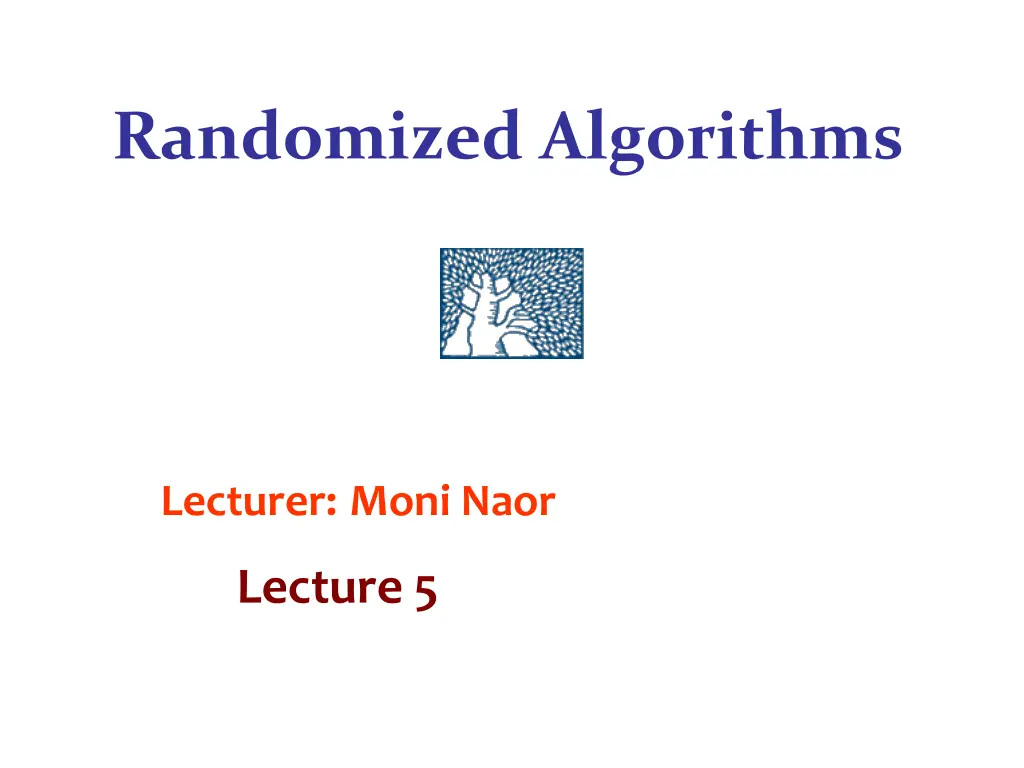
Randomized Algorithms Lecture by Moni Naor: Multi-set Equality and Hash Functions
Explore the concept of multi-set equality using hash functions in randomized algorithms. Learn about the construction, utilization, and analysis of algorithms for comparing multi-sets efficiently under low memory constraints.
Download Presentation

Please find below an Image/Link to download the presentation.
The content on the website is provided AS IS for your information and personal use only. It may not be sold, licensed, or shared on other websites without obtaining consent from the author. If you encounter any issues during the download, it is possible that the publisher has removed the file from their server.
You are allowed to download the files provided on this website for personal or commercial use, subject to the condition that they are used lawfully. All files are the property of their respective owners.
The content on the website is provided AS IS for your information and personal use only. It may not be sold, licensed, or shared on other websites without obtaining consent from the author.
E N D
Presentation Transcript
Randomized Algorithms Lecturer: Moni Naor Lecture 5
Recap and Today Recap Streaming Multiset equality Today Streaming Proof by encoding
Homework Recap Vague: Question: Why choose majority and not some other function for amplification? Question: why does Freivald s matrix multiplication checking work?
Multi-set equality We have two multi-sets A and B given in an arbitrary order. Once an element is given it cannot be accessed again (unless it is explicitly stored) and our goal a low memory algorithm for equality. Cannot hope to have a deterministic algorithm Idea: choose a function h and compute h(A) and h(B) gradually. h chosen from a family of hash functions H All the randomness comes from choice of h
Algorithm From the range of h Accumulators ??for A an ??for B Initialize ??and ??to 1 Choose a function ? Read next element c in the stream Say it is added to A Update ??: need to be able to compute (? {?}) from h, h(A) and c At end of stream: compare ??and ?? At any point in time ??should be h(A) seen so far ??should be h(B) seen so far Uniformly at random
Multi-set equality Need a family of functions H that is incremental in nature. For a function ?: Given h, h(A) and an element c: easy to compute (? {?}). For any two different multi-sets A and B the probability over the choice of ? that h(A) = h(B) is small. The description of h is short and the output of h is small.
Functions for Multi-set equality Treat the set A as defining a polynomial Polynomial is ?? revealed gradually as we learns the set (? ?) ??? = ? ? over a finite field of size is larger than the universe from which the elements of A are chosen+|A| say a prime Q > |U|. The members of the family H are called ?, for all y in GF[Q] and defined as ?(?) = ??(?).
Analysis The probability that two sets collide i.e. ?(?) = ?(?), which means that ??(?) = ??(?) is ???{|?|,|?|}/? This is the maximum number of points that two polynomials whose degree is at most max{|?|,|?|} can agree without being identical. Storing ?and storing (?) as it is computed requires just O(log Q) bits, The resulting algorithm never needs to store anything close in size to the original sets.
Model CPU needs to make sure what it read is what it wrote Accesses addresses q1, q2 Secure zone qi CPU Main memory Small private memory M[qi]
Open Question What happens when the size n of the set is unknown in advance
Question What if instead of multi-set equality we want to test set equality? No matter how many times an elements appears we count it once Theorem: set equality of sets of size n requires (n) bits of memory
Set disjointness or Set Intersection (One-Way) Communication Complexity: A B Alice: input x 0,1? Bob: input y 0,1?. Neither has any idea about other input Alice and Bob want to cooperate to compute a (Boolean) function f: 0,1? 0,1? {0,1}
Connection to Streaming Algorithms Small-space streaming algorithms imply low-communication 1-way protocols: Alice and Bob treat their inputs as streams. Alice sends to Bob the state when her input is over state A B Bob continues with the simulation
Disjointness Alice and Bob: each gets n-bit vectors x and y. Characteristic vectors of two subsets of the universe {1,2,...,n} Boolean function DISJ of the corresponding subset Claim: Every deterministic one-way communication protocol that computes DISJ requires n bits of communication in the worst case.
Disjointness Alice and Bob: each gets n-bit vectors x and y. Characteristic vectors of two subsets of the universe {1,2,...,n} Boolean function DISJ is 1 iff the corresponding subsets are disjoint. Theorem: Every randomized protocol that for every input (x,y) correctly decides the function DISJ with probability at least 2/3, uses (n) communication in the worst case
Lower bound for set equality through set equality Given two sets X and Y: want to know if they intersect Consider the sets {1,2,...,n} X ? the union of the complements of X and Y They are equal as sets iff X and Y do not intersect! Theorem: Every randomized streaming algorithm, protocol that correctly decides set equality require (n) bits of memory.
Streaming Suppose you want to compute a function on a stream of data but do not have enough memory to store it Which functions are computable? What accuracy Randomness essential A B
Example of a streaming problem: majority An array/stream of length n, elements from domain of size u Promise: there is a majority element, i.e. occurs strictly more than n/2 times. A simple one-pass algorithm, maintaining only the current candidate majority element and a counter for it - Boyer Moore.
Boyer Moore Majority Algorithm Initialize: current_guess m and a counter ? with ? = 0 Read next element x of the input sequence: If ? = 0: assign m x and i 1 else if ? = ? then i i + 1 else i i 1 Return m O(log n+ log u) bits One of the few deterministic algorithms in the area If a majority element exist, it is always returned
Computing on streams How many elements? How many different elements? What is the most frequent elements Who are the heavy hitters? Frequency Moments For element j U, let ?? {0,1,2,...,m} be the number of times that j occurs in the stream. For integer k, the kth frequency moment ?. ??:= ? ???
Computing on streams How many elements? How many different elements? What is the most frequent element Who are the heavy hitters? Frequency Moments For element j U, let ?? {0,1,2,...,m} be the number of times that j occurs in the stream. For integer k: the kth frequency moment ?. ??:= ? ???
Frequency Moments ? ??:= ?? ? ? The bigger k is, the more ??is dominated by the largest frequencies. Define ? = max ? ???as the largest frequency of any element of U.
Estimating ?? Strategy Find a randomized unbiased estimator of ??, which can be computed in one pass. Want a result that is correct on average. Aggregate many independent copies of the estimator, computed in parallel to get an estimate that is accurate with high probability How to aggregate?
Estimating ?? Should be independent of the stream. We will see that 4-wise ind. Is enough Let h:U { 1} be a ``random function that associates each universe element with a random sign. The function h is chosen at the beginning and stored Initialize Z=0 Every time a data stream element j U appears, add h(j) to Z. Increment Z if h(j) = +1 and decrement Z if h(j) = 1. Return the estimate ? = ?2.
Good Estimator Claim: For every data stream ? [X] =?? Linearity of expectations Ind. of the values of h Pairwise is enough!
Are Great Expectations Good Enough? Example: count the number of satisfying assignments of a given formula Better: use variance Recall: Markov s inequality (non-negative) Pr[? > ? ] ?[?]/? Chebychev s inequality Pr[|? ?[?]| ? ] ???[?]/?2 Chernoff-Hoeffding Inequality Need complete independence ??? ? = ?[(? ? ? 2] ? are Claim: If the ?? pairwise independent: then same variance
Good Variance Claim: For every data stream ??? [X] =2?? Why is this good enough? Let Y=1 ? ?=1 ?? The variance of t independent trials goes down as 1/t 4-wise independence sufficient ? 2 Claim: For every data stream, with ? = ? 2, 1 2 ?[? (1 ) ??] 1 ?. Pr
k-wise independence Approach: use k-wise independence for smallest k possible Definition: A family H of hash functions is k-wise independent if for any distinct x1,...,xk U and for any y1,...,yk [0,...,m-1]: Pr [h(x1)=y1^ h(x2)=y2^ ... ^ h(xk)=yk] = 1/mk h H
Constructing 3-wise independence Domain U be of size 2? Each element ? ? corresponds to a binary vector of length m+1 ?1,?2, ,??,1 The function ?is defined by a (random) vector R= ?1,?2, ,??,??+1 ?(x) = x,R = ?=1 Claim: every 3 vectors x,y and z are linearly ind. Claim: linear independent implies stochastic independence Family size is 2?+1 ?+1????mod 2

